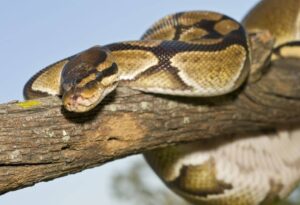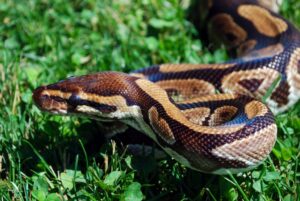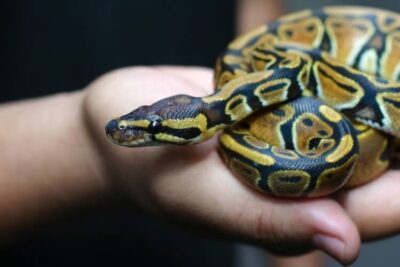Why is my ball python not eating? This common question can evoke worry and concern among snake owners. Ball pythons, known for their docile nature and relatively simple care requirements, sometimes exhibit behaviors that puzzle their keepers, especially when it comes to feeding.
Whether you’re a novice or experienced reptile enthusiast, understanding the reasons behind your ball python’s refusal to eat is crucial for their health and your peace of mind. Let’s delve into the complexities of ball python feeding habits and explore the potential factors contributing to their reluctance to consume food.
Why is my ball python not eating?

It’s totally normal to worry about your ball python when they’re not eating. There could be a few reasons why they’re not chowing down like usual. There are several reasons why your ball python might not be eating. Here are some common ones:
- Temperature and Humidity: Ball pythons are sensitive to their environment, especially temperature and humidity. If the temperature or humidity levels in their enclosure are not within the optimal range, they may refuse to eat. Make sure the temperature gradient in their enclosure is appropriate, with a warm side ranging from 88-92°F (31-33°C) and a cool side around 78-80°F (25-27°C). Humidity should be maintained between 50-60%.
- Stress: Ball pythons are easily stressed by changes in their environment, such as moving to a new enclosure, handling, or the presence of other pets. Stress can lead to a loss of appetite. Try to minimize disturbances and provide hiding spots to make your snake feel secure.
- Shedding: Before shedding, ball pythons often lose their appetite. This is a natural behavior as their metabolism slows down during the shedding process. Wait until they have completed shedding before offering food again.
- Seasonal Changes: Ball pythons may go off feed during certain times of the year, particularly in the winter months. This behavior is more common in adult snakes and is related to breeding cycles and environmental changes. It’s usually nothing to worry about as long as the snake is otherwise healthy.
- Illness or Parasites: If your ball python is not eating and also displaying other symptoms such as weight loss, lethargy, or abnormal behavior, it could indicate an underlying health issue. Internal parasites, respiratory infections, and other illnesses can cause a loss of appetite. If you suspect your snake is unwell, it’s best to consult a veterinarian who specializes in reptiles for a proper diagnosis and treatment.
- Diet Preferences: Sometimes ball pythons can be picky eaters, especially if they have been fed a particular type of prey for a long time. Experimenting with different prey items or offering freshly killed prey may help stimulate their appetite.
If your ball python continues to refuse food for an extended period or if you’re concerned about their health, it’s always best to seek advice from a reptile veterinarian. They can provide guidance tailored to your snake’s specific needs and help ensure they remain happy and healthy.
Common concerns when a ball python refuses to eat
When your ball python refuses to eat, it’s natural to feel concerned. Here are some common worries that snake owners often have:
- Health Issues: The most immediate concern is often whether the snake is sick or has a health issue causing the lack of appetite. Owners may worry about illnesses such as respiratory infections, parasites, or metabolic disorders.
- Stress: Stress can be a significant factor in a ball python’s refusal to eat. Changes in environment, handling, or the presence of other animals can all cause stress for your snake.
- Environmental Factors: Owners may worry that something is wrong with the snake’s habitat. Issues such as incorrect temperatures, improper humidity levels, or an inadequate hiding place can all affect a ball python’s appetite.
- Shedding: Ball pythons commonly go off feed before shedding their skin. While this is a natural behavior, owners may worry if they’re not familiar with this aspect of snake behavior.
- Seasonal Changes: Ball pythons may also refuse to eat during certain times of the year, especially in the winter. This behavior, known as brumation, is more common in adult snakes and is influenced by factors such as temperature and daylight.
- Dietary Preferences: Owners may worry that their snake has become a picky eater, especially if they’ve been feeding it the same type of prey for a long time. They may worry about how to entice their snake to eat or whether they should try switching prey items.
- Age and Growth: Some owners worry if their snake’s refusal to eat is related to its age or growth stage. Younger snakes typically eat more frequently than adults, and their appetite may fluctuate as they grow.
- Impact on Health and Weight: Owners may worry about the potential impact of prolonged fasting on their snake’s health and weight. They may wonder how long a snake can safely go without eating and if they need to intervene.
Addressing these concerns involves careful observation of your snake’s behavior, ensuring their habitat is appropriate, and consulting with a reptile veterinarian if necessary. In many cases, a ball python’s refusal to eat is temporary and resolves on its own, but it’s essential to monitor their health and well-being closely.
Normal Feeding Behavior of Ball Pythons

Ball pythons are generally known for their relatively calm and docile nature, especially when it comes to feeding. Here’s what you can typically expect in terms of their feeding behavior:
- Ambush Predators: In the wild, ball pythons are ambush predators. They rely on stealth and patience to catch their prey. This behavior often translates to their feeding habits in captivity.
- Opportunistic Feeders: Ball pythons are opportunistic feeders, meaning they will consume prey when it’s available, but they can also go for extended periods without eating. This behavior allows them to adapt to fluctuations in food availability in their natural habitat.
- Feeding Response: When offered food, a healthy ball python will usually display a feeding response. This might include flicking their tongue, tracking the prey item’s movement, and eventually striking at it to grab it with their teeth.
- Constriction: After successfully striking their prey, ball pythons will typically constrict it to subdue it before swallowing. This constriction behavior helps them overpower larger prey items and prevents their prey from escaping.
- Swallowing: Once the prey is subdued, the ball python will begin the process of swallowing it whole. They have specialized jaws that allow them to stretch their mouths around prey items much larger than their own heads.
- Digestion: After consuming their meal, ball pythons undergo a period of digestion. This process can take several days to weeks, depending on the size of the prey item and the snake’s metabolism. During this time, they may appear lethargic and prefer to remain hidden in their enclosure.
- Feeding Frequency: Ball pythons typically feed on a schedule determined by their age, size, and individual metabolism. Younger snakes generally eat more frequently, often every 5-7 days, while adults may eat every 7-14 days or even less frequently.
- Refusal to Eat: While ball pythons are generally good eaters, they may occasionally refuse food. This can happen for various reasons, including stress, environmental factors, shedding, or simply because they’re not hungry. A single missed meal is usually not a cause for concern, but prolonged refusal to eat may warrant closer attention and possibly a veterinary check-up.
Understanding these typical feeding behaviors can help snake owners provide appropriate care and recognize any changes or abnormalities in their ball python’s eating habits.
20 Reasons Your Ball Python May Not Be Eating
Here are 20 reasons why your ball python may not be eating:
- Incorrect Temperature: Ball pythons require specific temperature gradients in their enclosure for proper digestion. If the temperatures are too low or too high, they may refuse to eat.
- Inadequate Humidity: Insufficient humidity levels can lead to difficulty shedding and dehydration, both of which can affect appetite.
- Stress: Changes in their environment, handling, or the presence of other pets can stress ball pythons and cause them to stop eating.
- Improper Lighting: While ball pythons are primarily nocturnal, they still require a day-night cycle. Inadequate lighting or irregular light cycles can disrupt their feeding patterns.
- Recent Feeding: Ball pythons may refuse food if they’ve been recently fed or are in the process of digesting a meal.
- Shedding: Ball pythons commonly go off feed before shedding their skin. This is a natural behavior and typically resolves once they’ve completed shedding.
- Brumation: During the cooler months, ball pythons may enter a period of reduced activity known as brumation. They may eat less or refuse food altogether during this time.
- Seasonal Changes: Changes in temperature, daylight, and other environmental factors can affect a ball python’s appetite.
- Age and Growth: Young ball pythons tend to eat more frequently than adults. Their feeding habits may change as they grow and mature.
- Dietary Preferences: Ball pythons may develop preferences for certain prey items or feeding methods. Offering a variety of prey types and feeding strategies can help stimulate their appetite.
- Illness or Injury: Health issues such as respiratory infections, parasites, mouth rot, or injuries can lead to a loss of appetite in ball pythons.
- Internal Parasites: Parasitic infections can cause gastrointestinal discomfort and affect a snake’s appetite.
- Overweight: Obesity can lead to reduced appetite and other health problems in ball pythons. If your snake is overweight, it may need to be placed on a diet.
- Underweight: Underweight snakes may also refuse food. It’s essential to monitor their weight and adjust feeding accordingly.
- Enclosure Size: A too-large or too-small enclosure can stress out ball pythons and affect their feeding behavior.
- Prey Size: Offering prey items that are too large can intimidate ball pythons and cause them to refuse food.
- Feeding Schedule: Ball pythons may become accustomed to a particular feeding schedule and refuse food if it’s changed suddenly.
- Food Source: The quality and freshness of the prey item can affect a ball python’s willingness to eat.
- Breeding Season: Breeding activity can affect a ball python’s appetite. Males, in particular, may lose interest in food during the breeding season.
- Environmental Disturbances: Loud noises, vibrations, or other disturbances near the snake’s enclosure can stress them out and affect their appetite.
If your ball python is not eating, it’s essential to carefully evaluate its environment, health, and other potential factors that may be influencing its appetite. If you’re concerned, consulting with a reptile veterinarian can help identify and address any underlying issues.

Steps to Encourage Ball Python Eating
Encouraging a ball python to eat can sometimes require a bit of patience and experimentation. Here are some steps you can take to help stimulate their appetite:
- Check the Environment: Ensure that the temperature and humidity levels in the enclosure are appropriate for your ball python’s species. Use a reliable thermometer and hygrometer to monitor these parameters.
- Provide Hiding Places: Ball pythons are shy creatures and feel more secure when they have hiding spots in their enclosure. Make sure there are plenty of hiding places, such as caves or branches, where your snake can retreat and feel safe.
- Offer Fresh Water: Always provide clean, fresh water for your ball python. Hydration is crucial for their overall health and can also stimulate their appetite.
- Try Different Prey Items: If your ball python is refusing one type of prey, try offering a different type. Some snakes may have preferences for certain prey species or sizes. Experiment with live, freshly killed, and thawed frozen prey to see what your snake prefers.
- Warm Up the Prey: Ball pythons are more likely to eat prey that is warm to the touch. You can warm up frozen-thawed rodents by soaking them in warm water or using a heat lamp or heating pad to raise their temperature slightly.
- Use Scenting Techniques: If your ball python is particularly finicky, you can try scenting the prey item with something they find appealing, such as chicken broth or lizard scent. Rub the prey item with the scent before offering it to your snake.
- Feed in the Evening: Ball pythons are primarily nocturnal hunters, so they may be more receptive to feeding in the evening or at night. Try offering food during these times when your snake is more active.
- Limit Handling: Minimize handling your ball python, especially around feeding time. Handling can stress out snakes and make them less likely to eat.
- Be Patient: It’s normal for ball pythons to go through periods of fasting, especially during seasonal changes or when they’re about to shed. If your snake skips a meal or two, don’t panic. Monitor their weight and behavior, and try offering food again in a week or so.
- Seek Veterinary Advice: If your ball python continues to refuse food for an extended period or if you’re concerned about their health, it’s always best to consult with a reptile veterinarian. They can provide guidance tailored to your snake’s specific needs and help ensure they remain healthy.
By following these steps and being patient and observant, you can often encourage a reluctant ball python to start eating again.
Conclusion
Why is my ball python not eating? is a common concern among snake owners. Several factors could contribute to this behavior, including environmental conditions, stress, shedding, seasonal changes, and health issues.
By carefully evaluating the snake’s habitat, providing appropriate prey options, and minimizing stressors, owners can often encourage their ball pythons to resume eating. However, if the problem persists or if there are signs of illness, seeking veterinary advice is recommended to ensure the snake’s well-being.

